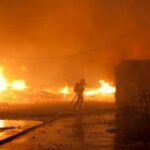Fire Safety Tips for the Workplace

Oct. 7-13, 2012 is Fire Prevention Week. Although this week is geared toward fire safety at home, it’s still a good time to think about fire safety in the workplace, too.
As with any safety hazard, the OHS laws require you to take steps to protect workers in the event of a workplace fire. You can do so through a fire safety plan that should:
- Include measures to control fire hazards, such as storage of flammable substances and explosives
- Spell out procedures in case of a fire, including sounding the fire alarm, notifying the fire department and evacuating workers and others
- Identify individuals designated to carry out specific duties under the plan and describe their responsibilities
- Describe the training that must be provided to each individual with fire response duties
- Address the procedures for and frequency of fire drills to verify the effectiveness of the plan as well as identify and correct weaknesses.
You should also make sure that your workplace has appropriate fire suppression and protection equipment, such as fire and smoke alarms, fire extinguishers and sprinkler systems, and ensure that this equipment is working properly.
Also make sure that workers can easily find and access fire extinguishers. The time spent trying to locate an extinguisher could mean the difference between life and death.
Example: A welder in New Brunswick was welding a pipe in a warehouse from an elevated platform. When a fire broke out, there wasn’t a fire extinguisher nearby. By the time he found one, the fire had engulfed the warehouse’and a worker died. Lesson: Compliance with the requirement that a fire extinguisher be readily available where welding is performed could’ve saved this worker’s life.
And make sure that your emergency exits and fire doors aren’t blocked.
Example: A worker at an Ontario car wrecking yard was removing a gas tank from a car when gas spilled out of the tank and was ignited by a nearby lamp. Because the emergency exit was blocked, three workers were forced to run to the other end of the building to escape. As a result, all three suffered burns and smoke inhalation. The employer was fined $5,000 for failing to ensure that emergency exits were free from obstructions and another $55,000 for failing to provide information, instruction and supervision to a worker for the safe removal of a gas tank.